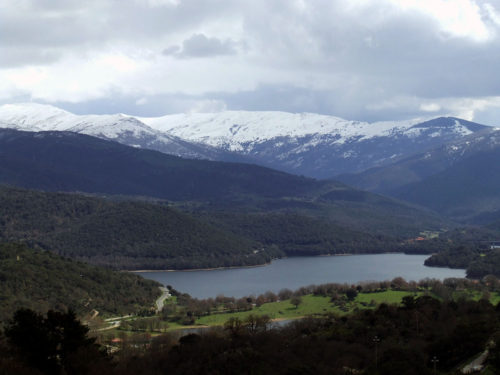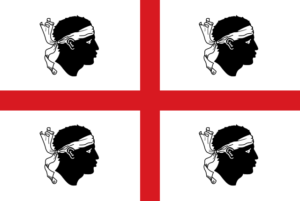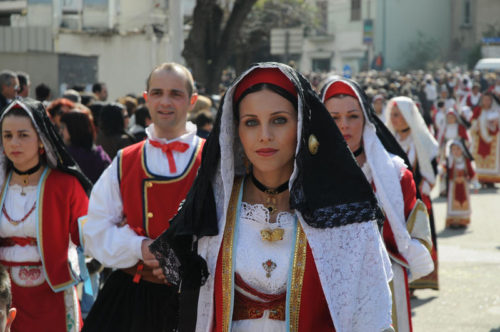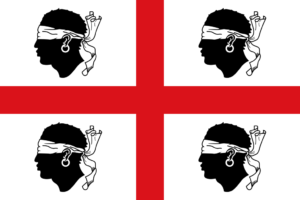Sardinia’s Flag: Four Beheaded Non-Whites
MOST SOURCES say that the origin of the Sardinian flag (pictured) is “shrouded in mystery.” In some cases, this claim is an effort to imply that the “mystery” revolves around the meaning of the four Black heads on the flag. That is not so. There is no mystery about that. The heads are intended to represent the severed and blindfolded heads of defeated and executed non-White Muslim invaders (usually called Moors, Blackamoors, or Saracens prior to the 20th Century). The Four Moors also appear on the coat of arms of Sardinia. The only real mystery involves the exact lineage of the design, and whether or not there is a Spanish connection to the imagery.
Sardinia is an autonomous island region of Italy, located just south of Corsica, and was once an independent kingdom in its own right. Its human culture can be traced far into prehistory. It is the home of the prehistoric megalithic temple of Monte d’Accoddi. Sardinia was heavily bombed by the Allies during World War 2.

The aspects of the flag’s origin that actually are in dispute are these: Was the flag of native Sardinian origin, or was it adopted when Sardinia was under the domination of the House of Aragon? No knowledgeable person, however, doubts that the flag celebrates the defeat and execution of non-White Muslim invaders.

From the 13th Century until 1999, the flag of Sardinia was exactly as shown above — but in that year, the island’s leaders were persuaded to adopt a somewhat less bloodthirsty version: the Moors’ heads now face in the opposite direction, and the blindfolds have been slipped up on the foreheads so they look more like headbands, and the eyes of the Moors are open — possibly implying that they are still alive and haven’t been executed after all. To be fair, though, many different artists’ versions of the symbol have existed for centuries.
The Four Moors symbol was reportedly presented on a red banner delivered by Pope Benedetto VIII to Pisan, who helped the Genoese and Sardinians during a battle against the Saracens, who were trying to conquer the Italian peninsula and Sardinia in 1015. This banner has now been lost and only references to it remain.

According with an ancient Spanish and Aragonese legend, the symbol was created by King Pietro I of Aragon, who defeated the Moorish invaders with, it was once believed, “the help of St. George.” The banner closely resembles that of England, which also features the red-on-white cross of St. George (but without the severed heads). Pietro beheaded the four commanders of the Saracen army. The symbol was then adopted by the royal house of Aragon, and we have evidence of this in the form of lead seals dated 1281 showing the Four Moors, though without bandages.
When Sardinia fell under Spanish rule in 1297, the Four Moors flag became finally the official banner of the Kingdom of Sardinia.
The flag of the Four Moors appears on a circa 1370 manuscript called the Armorial of Gerle, today preserved in the Royal Library of Brussels, which reproduced all the coats of arms of the European countries including the Kingdom of Sardinia. In this document the Four Moors are definitively linked to Sardinia and are shown without the white band, with their heads bare, in a white field divided by the cross of St. George.






